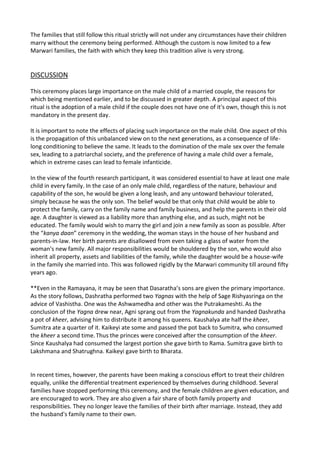This document provides an overview and analysis of the Parojan ritual tradition in the Marwari community in India. Parojan is a ritual performed for all members of a family, especially male members, before marriage. It involves ceremonies over multiple days where the family offers prayers and food offerings to their Kul Devi (family deity). Traditionally, the presence of a male child was necessary for the ritual, though families without sons would adopt or use a coconut as a symbol. The document examines the history and details of the ritual through interviews with participants and elders in the community. It finds that while Parojan was strictly followed in the past, modern families have adapted the tradition with some modifying the gender requirements.




![SUMMARY
Parojan, along with it's sub-rituals are performed during the same consecrated days on which
marriages are to take place, according to the Marwari calendar. The ritual is of great importance in
the community, and is performed in a most extravagant manner, attended by every member of
the extended family, and held for between four and seven days at the native place of the married
couple. My own family has been practising this ritual as a custom for several generations.
With regards to the ritual, it is either performed in a grand manner, or not at all. In the present
day, the importance and faith people place in rituals has been diluted. Instead, practicality in life,
and living accordingly, are of greater concern. There is conscious effort among the people to
ensure that men and women are treated equally. Due to all these factors, the relevance of Parojan
is shrinking rapidly, and the custom is doomed to fade away, sooner rather than later.
REFERENCES
*PBS NEWSHOUR. (2013). Pervasive Preference for Baby Boys Over Girls Prevails Among Parents in
India. [Online Video]. 23 April. Available from: http://www.pbs.org/newshour/bb/world/janjune13/india_04-23.html. [Accessed: 02 October 2013].
**Wikipedia. 2013. Dasharatha. [ONLINE] Available at: http://en.wikipedia.org/wiki/Dasharatha.
[Accessed 22 October 13].
APPENDICES
3 interview recordings
One telephonic interview wherein the first research participant interview the second.
2 face to face interviews with the first and the fourth research participants.](https://image.slidesharecdn.com/parojan-131023031746-phpapp01/85/Parojan-5-320.jpg)